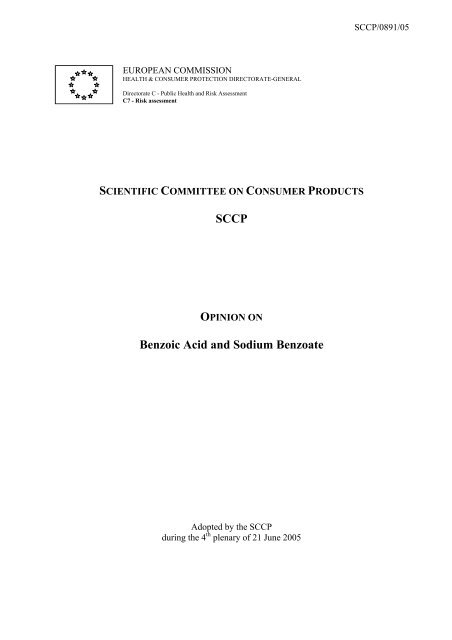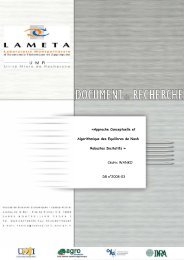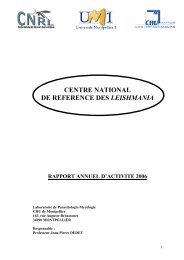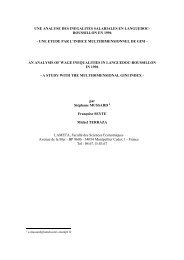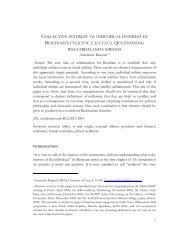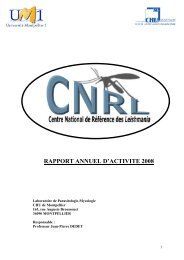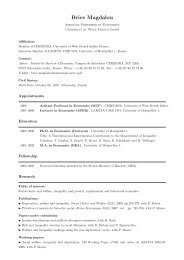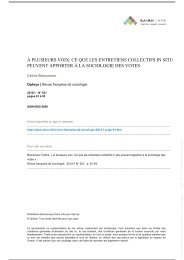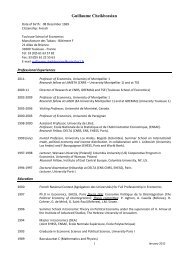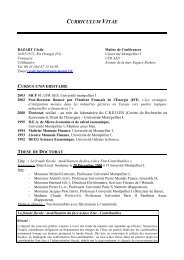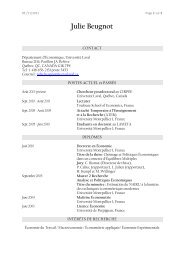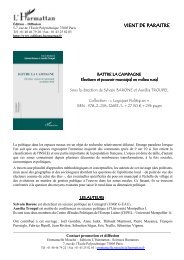Benzoic Acid and Sodium Benzoate - European Commission
Benzoic Acid and Sodium Benzoate - European Commission
Benzoic Acid and Sodium Benzoate - European Commission
Create successful ePaper yourself
Turn your PDF publications into a flip-book with our unique Google optimized e-Paper software.
SCCP/0891/05<br />
EUROPEAN COMMISSION<br />
HEALTH & CONSUMER PROTECTION DIRECTORATE-GENERAL<br />
Directorate C - Public Health <strong>and</strong> Risk Assessment<br />
C7 - Risk assessment<br />
SCIENTIFIC COMMITTEE ON CONSUMER PRODUCTS<br />
SCCP<br />
OPINION ON<br />
<strong>Benzoic</strong> <strong>Acid</strong> <strong>and</strong> <strong>Sodium</strong> <strong>Benzoate</strong><br />
Adopted by the SCCP<br />
during the 4 th plenary of 21 June 2005
Opinion on <strong>Benzoic</strong> <strong>Acid</strong> <strong>and</strong> <strong>Sodium</strong> benzoate<br />
SCCP/0891/05<br />
TABLE OF CONTENTS<br />
1. BACKGROUND ………………………………………………… 3<br />
2. OPINION ………………………………………………… 4<br />
3. CONCLUSION ………………………………………………… 25<br />
4. MINORITY OPINION ………………………………………………… 25<br />
5. REFERENCES ………………………………………………… 25<br />
6. ACKNOWLEDGEMENTS ............................................................................ 29<br />
2
Opinion on <strong>Benzoic</strong> <strong>Acid</strong> <strong>and</strong> <strong>Sodium</strong> benzoate<br />
SCCP/0891/05<br />
1. BACKGROUND<br />
1.1. Background<br />
The Scientific Committee on Cosmetic Products <strong>and</strong> Non-Food Products intended for<br />
Consumers (SCCNFP) was requested to review the data submitted to support the safety of<br />
benzoic acid, its salts <strong>and</strong> esters (COLIPA 1 No. P 2), when used at concentrations other than<br />
those laid down in Annex VI to Directive 76/768/EEC as preservatives, for other specific nonpreservative<br />
purposes apparent from the presentation of the products.<br />
The SCCNFP adopted an opinion on 4 June 2002 on <strong>Benzoic</strong> acid <strong>and</strong> <strong>Sodium</strong> benzoate<br />
(SCCNFP/0532/01, final). In its opinion the SCCNFP stated, that “the SCCNFP can only assess<br />
the safety of substances for which appropriate data has been submitted for evaluation. Safety<br />
assessment is specific <strong>and</strong> not generic. Only toxicological data for benzoic acid <strong>and</strong> its salt<br />
sodium benzoate have been made available for review. Therefore, there is no review of other<br />
salts of benzoic acid or any of its esters. These will require separate evaluation when the<br />
necessary data have been made available.”<br />
It was stated furthermore, that “the SCCNFP does not find the submission appropriate for a<br />
safety evaluation of benzoic acid <strong>and</strong> sodium benzoate for the applied “other uses” in cosmetic<br />
products”.<br />
Recently, the <strong>European</strong> <strong>Commission</strong> received Submission II on <strong>Benzoic</strong> acid, its salt <strong>and</strong> esters.<br />
2. TERMS OF REFERENCE<br />
1. On the basis of provided data the SCCP is asked to assess the risk to consumers when<br />
<strong>Benzoic</strong> acid, its salts <strong>and</strong> esters are used for non-preservative purposes in cosmetic rinse-off<br />
products at a maximum concentration of 2.5 % <strong>and</strong> in cosmetic oral-care products at a<br />
maximum concentration of 1.7 %, <strong>and</strong> in leave-on products up to 0.5%.<br />
2. Does the SCCP recommend any further restrictions with regard to the use of <strong>Benzoic</strong> acid,<br />
its salts <strong>and</strong> esters safe when used for non-preservative purposes in cosmetic products?<br />
1 COLIPA – <strong>European</strong> Cosmetics Toiletry <strong>and</strong> Perfumery Association<br />
3
Opinion on <strong>Benzoic</strong> <strong>Acid</strong> <strong>and</strong> <strong>Sodium</strong> benzoate<br />
SCCP/0891/05<br />
3. OPINION<br />
3.1. Chemical <strong>and</strong> Physical Specifications<br />
3.1.1. Chemical identity<br />
3.1.1.1. Primary name <strong>and</strong>/or INCI name<br />
<strong>Benzoic</strong> acid (INCI name)<br />
<strong>Sodium</strong> benzoate (INCI name)<br />
3.1.1.2. Chemical names<br />
<strong>Benzoic</strong> acid<br />
<strong>Sodium</strong> benzoate<br />
Benzene carboxylic acid; benzene formic acid; carboxybenzene; benzene<br />
carboxylic acid; phenylcarboxyl acid; phenylformic acid, E210<br />
E211<br />
3.1.1.3. Trade names <strong>and</strong> abbreviations<br />
/<br />
3.1.1.4. CAS / EINECS / ELINECS number<br />
CAS<br />
EINECS<br />
<strong>Benzoic</strong> acid : 65-85-0 200-618-2<br />
<strong>Sodium</strong> benzoate : 532-32-1 208-534-8<br />
3.1.1.5. Structural formula<br />
<strong>Benzoic</strong> acid<br />
<strong>Sodium</strong> benzoate<br />
3.1.1.6. Empirical formula<br />
<strong>Benzoic</strong> acid : C 7 H 6 O 2<br />
<strong>Sodium</strong> benzoate : C 7 H 5 O 2 Na<br />
3.1.2. Physical form<br />
<strong>Benzoic</strong> acid : solid<br />
<strong>Sodium</strong> benzoate : solid<br />
4
Opinion on <strong>Benzoic</strong> <strong>Acid</strong> <strong>and</strong> <strong>Sodium</strong> benzoate<br />
SCCP/0891/05<br />
3.1.3. Molecular weight<br />
<strong>Benzoic</strong> acid : 122.13<br />
<strong>Sodium</strong> benzoate : 144.11<br />
3.1.4. Purity, composition <strong>and</strong> substance codes<br />
No data<br />
3.1.5. Impurities / accompanying contaminants<br />
No data<br />
3.1.6. Solubility<br />
<strong>Benzoic</strong> acid : 2.91 g/l in water at 20 o C<br />
<strong>Sodium</strong> benzoate : 556 g/l in water at 20 o C, hygroscopic<br />
3.1.7. Partition coefficient (Log P ow )<br />
<strong>Benzoic</strong> acid : 1.88<br />
<strong>Sodium</strong> benzoate : -2.269<br />
3.1.8. Additional physical <strong>and</strong> chemical specifications<br />
<strong>Benzoic</strong> acid<br />
Organoleptic properties : /<br />
Melting point : 122 °C<br />
Boiling point : 249.2°C<br />
Flash point : /<br />
Vapour pressure : 0.0011hPa<br />
Density : 1.321 g/cm 3 at 20°C<br />
Viscosity : /<br />
pKa : -2.269<br />
Refractive index : /<br />
Stability : /<br />
<strong>Sodium</strong> benzoate<br />
Organoleptic properties :<br />
Melting point : >300.0 °C<br />
Boiling point : 464.9°C<br />
Flash point : /<br />
Vapour pressure : 0.0011hPa<br />
Density :<br />
Viscosity : /<br />
pKa : -2.269<br />
Refractive index : /<br />
Stability : /<br />
5
Opinion on <strong>Benzoic</strong> <strong>Acid</strong> <strong>and</strong> <strong>Sodium</strong> benzoate<br />
SCCP/0891/05<br />
3.2. Function <strong>and</strong> uses<br />
<strong>Benzoic</strong> acid is a natural ingredient occurring in many foodstuffs <strong>and</strong> in plant extracts.<br />
<strong>Benzoic</strong> acid, its salts <strong>and</strong> esters are used as preservatives in cosmetic products, with a maximum<br />
concentration of 0.5 %, (calculated as acid), as regulated by the EU Cosmetics directives<br />
76/768/EEC.<br />
This request is for use for non-preservative purposes in cosmetic rinse-off products, at a<br />
maximum concentration of 2.5 %, <strong>and</strong> in cosmetic oral-care products, at a maximum<br />
concentration of 1.7 %, <strong>and</strong> in leave-on products, up to 0.5%. However these purposes are not<br />
specified.<br />
Other uses for benzoic acid <strong>and</strong> its salts include regulated use as food preservatives, most<br />
suitable for foods, fruit juices, <strong>and</strong> soft drinks in an acidic pH range. In the EU, there are<br />
regulations controlling the maximum levels of benzoic acid <strong>and</strong> its salts for use in foodstuffs<br />
ready for consumption <strong>and</strong> the specific purity criteria of food additives. The levels are expressed<br />
as the free acid.<br />
Non alcoholic drinks<br />
Alcoholic drinks<br />
Jams & jellies<br />
Aspic<br />
150 mg/l<br />
200 mg/l<br />
500 mg/kg<br />
500 mg/kg<br />
Ref.: AR 1, AR 2<br />
In the United States, benzoic acid <strong>and</strong> sodium benzoate are on the FDA list of substances that are<br />
generally recognized as safe (GRAS). Both may be used as antimicrobial agents, flavouring<br />
agents <strong>and</strong> as adjuvants with a current maximum level of 0.1% in food. The FDA has not<br />
determined whether significantly different conditions of use would be GRAS. The FDA has<br />
sought fully up-to-date toxicology information.<br />
Ref.: AR 3<br />
<strong>Benzoic</strong> acid is used in oral medicines up to 0.15%, in parenteral medicines up to 0.17% <strong>and</strong> in<br />
topical drugs up to 0.2%. <strong>Benzoic</strong> acid is used as an active ingredient in anti-fungal cream with<br />
salicylic acid (3.0%) up to 6%.<br />
<strong>Sodium</strong> <strong>Benzoate</strong>, expressed as benzoic acid, is permitted in oral medicines up to 0.5%, in<br />
parenterally administered up to 0.5%.<br />
Ref.: AR 4, AR 5<br />
<strong>Benzoic</strong> acid is also an intermediate in the synthesis of phenol <strong>and</strong> caprolactam. Other end<br />
products include sodium <strong>and</strong> other benzoates, benzoyl chloride, <strong>and</strong> diethylene <strong>and</strong> dipropylene<br />
glycol dibenzoate plasticizers. <strong>Sodium</strong> benzoate is primarily a preservative <strong>and</strong> corrosion<br />
inhibitor (e.g., in technical systems as an additive to automotive engine antifreeze coolants).<br />
6
Opinion on <strong>Benzoic</strong> <strong>Acid</strong> <strong>and</strong> <strong>Sodium</strong> benzoate<br />
SCCP/0891/05<br />
3.3. Toxicological Evaluation<br />
3.3.1. Acute toxicity<br />
3.3.1.1. Acute oral toxicity<br />
Acute oral toxicity information is based on summary information, no dossiers were provided.<br />
The indication is that the substances can be considered to possess low acute oral toxicity. The<br />
calculated LD 50 values taken from the available experiments on the acute oral toxicity of<br />
<strong>Benzoic</strong> <strong>Acid</strong> <strong>and</strong> <strong>Sodium</strong> <strong>Benzoate</strong> are listed in the following tables:<br />
<strong>Benzoic</strong> <strong>Acid</strong><br />
Species LD 50 [mg/kg] Reference<br />
Rats 1700<br />
2530 4<br />
Mice 1940 5<br />
2370 6<br />
<strong>Sodium</strong> <strong>Benzoate</strong><br />
Species LD 50 [mg/kg] Reference<br />
Rats 1714 7<br />
2100 fasting 8<br />
3140 9<br />
3450 not fasted 8<br />
4070 10<br />
3.3.1.2. Acute dermal toxicity<br />
<strong>Benzoic</strong> acid<br />
Rabbit<br />
LD 50 > 5 000 mg/kg<br />
LD 50 > 10 000 mg/kg<br />
Ref.: 14, citation only<br />
3.3.1.3. Acute inhalation toxicity<br />
No data submitted with Submission II (2004)<br />
<strong>Benzoic</strong> acid<br />
Rats<br />
LC 50 > 0.026 mg/l/h<br />
Ref.: 14, citation only<br />
7
Opinion on <strong>Benzoic</strong> <strong>Acid</strong> <strong>and</strong> <strong>Sodium</strong> benzoate<br />
SCCP/0891/05<br />
3.3.2 Irritation <strong>and</strong> corrosivity<br />
3.3.2.1. Skin irritation<br />
Animal studies<br />
<strong>Benzoic</strong> <strong>Acid</strong><br />
Guideline : OECD 404 (1981), EEC test method B.4, Annex V of EEC Directive<br />
84/449/EEC (September 1984)<br />
Species/strain : New Zeal<strong>and</strong> albino rabbit<br />
Group size : 3 females<br />
Test substance : 0.5 g of benzoic acid moistened with 0.25 ml Milli-RO water<br />
Batch : /<br />
Purity : 99.5%<br />
GLP : in compliance<br />
A paste, (0.5 g benzoic acid <strong>and</strong> 0.25 ml water), was applied evenly to 6 cm 2 Metalline on a<br />
permeable tape (Micropore). This was applied to the right flank of the rabbit. A control patch<br />
without the test substance was applied to the left flank. These were left in place for 4 hours. The<br />
test site was cleaned first with a dry tissue <strong>and</strong> then by swabbed with a dampened tissue. The<br />
skin was examined for erythema, eschar formation <strong>and</strong> oedema at 1, 24, 48 <strong>and</strong> 72 hours after<br />
removal of the patches.<br />
Results<br />
Two animals showed slight erythema initially. 1 of these also showed slight oedema up to 24 h.<br />
This was resolved by 48 h. There was no indication of a systemic effect.<br />
The results of this study indicate that the test item, benzoic acid, was minimally irritating<br />
(modified primary irritation index (PII) of 0.5) when applied to the intact rabbit skin under semiocclusive<br />
patch conditions. The test substance does not need to be labelled as a skin irritant.<br />
Ref.: 12<br />
In submission II, three additional animal tests confirmed the low irritation potential of <strong>Benzoic</strong><br />
<strong>Acid</strong> were summarized in a table. These were also provided in Submission I, but are only<br />
citations or summary information.<br />
Species Exposure Skin irritation Reference<br />
rabbits neat <strong>Benzoic</strong> acid/occluded / 24 h mild 13<br />
rabbits 500 mg dry powder/ 24 <strong>and</strong> 72h PII = 1.66/8.00 14<br />
rabbits 500 mg dry powder/ semiocclusive / 24 h not irritating 15<br />
<strong>Sodium</strong> <strong>Benzoate</strong><br />
Guideline : OECD 404 (1981)<br />
Species/strain : New Zeal<strong>and</strong> albino rabbit<br />
Group size : 3 females<br />
Test substance : 0.5 g sodium benzoate moistened with 0.25 ml Milli-RO water<br />
Batch : /<br />
Purity : > 99.5%<br />
8
Opinion on <strong>Benzoic</strong> <strong>Acid</strong> <strong>and</strong> <strong>Sodium</strong> benzoate<br />
SCCP/0891/05<br />
GLP : in compliance<br />
Approximately 24 hours prior to the treatment, the dorsal fur was shaved. A paste, (0.5 g sodium<br />
benzoate <strong>and</strong> 0.25 ml water), was applied evenly to 6 cm² Metalline on a permeable tape<br />
(Micropore). The 6 cm² patch was removed four hours after semi-occlusive contact. The skin<br />
reactions were assessed approx. 1 hour, 24, 48 <strong>and</strong> 72 hours after termination of the exposure.<br />
Under the conditions of the study, sodium benzoate was neither corrosive nor irritating (PII 0)<br />
when applied to the intact rabbit skin under semi-occlusive patch conditions for four hours. The<br />
test substance does not need to be labelled as a skin irritant. The animals did not show any<br />
symptoms of systemic intoxication.<br />
Ref.: 16<br />
Application of 500 mg sodium benzoate as a dry powder to rabbit for 24 h; responses were<br />
scored at end of treatment <strong>and</strong> after 48 h. It was considered not irritating.<br />
There are no details of study.<br />
Ref.: 17<br />
Human Studies<br />
<strong>Benzoic</strong> <strong>Acid</strong><br />
The results, presented only in scientific papers, are from studies both on volunteers <strong>and</strong> patients<br />
from dermatological clinics. 2% benzoic acid in petrolatum over 46h did not irritate intact skin<br />
of healthy volunteers. 24h application of 30% benzoic acid in ethanol was found to be the lowest<br />
irritating concentration.<br />
Ref. : Gad et al, 1986, Kligman, 1977, Frosch & Kligman, 1976 cited in 13<br />
Chamber test (72 h/occlusive): 0.1 ml of 7.5 % <strong>and</strong> 15 % benzoic acid in ethanol on scarified<br />
skin, 30 % benzoic acid in ethanol on normal skin (6 volunteers).<br />
Results<br />
Scarified skin : 7.5 % in ethanol, moderate irritant<br />
15.0 % in ethanol : marked irritant with erosions<br />
Normal skin : 30 % in ethanol, lowest irritant concentration<br />
Ref.: 19, 21<br />
Chamber test (20 min/occlusive), open test (30 min): 15 µl of 5 % benzoic acid in petrolatum, 15<br />
atopic <strong>and</strong> 16 non-atopic patients. The atopics showed redness in both the chamber test, (73 %)<br />
<strong>and</strong> the open test, (80 %). Non-atopics showed 80% redness in both the chamber test <strong>and</strong> in the<br />
open test. There was no statistical difference between atopics <strong>and</strong> non-atopics.<br />
Ref.: 20<br />
8 out of 627 patients (1.3%) from dermatological clinics showed positive reactions to 5 %<br />
benzoic acid, in petrolatum under an occlusive dressing for 24 or 48 h. At this concentration, the<br />
authors suggest that these results could be interpreted as marginally irritating, rather than<br />
allergic.<br />
Ref.: 18<br />
9
Opinion on <strong>Benzoic</strong> <strong>Acid</strong> <strong>and</strong> <strong>Sodium</strong> benzoate<br />
SCCP/0891/05<br />
Non-immunologic contact urticaria<br />
<strong>Benzoic</strong> acid (5.0 % in petrolatum) was tested in an open test on 29 atopic <strong>and</strong> 74 non-atopic<br />
persons.<br />
Results<br />
Contact urticarial reactions to benzoic acid were seen in 27/29 (93 %) of the atopics <strong>and</strong> in 64/74<br />
(87 %) of the non-atopics.<br />
In the chamber test, 20 min occlusion (recorded 10 min later) 0.1 % benzoic acid in petrolatum<br />
<strong>and</strong> 0.05 % benzoic acid in water elicited reactions. When water was the vehicle, the reactions<br />
were oedematous.<br />
Ref.: AR6<br />
Urticaria occurred in 1/10 <strong>and</strong> 5/12 healthy volunteers with 0.1 <strong>and</strong> 1.0% benzoic acid, following<br />
20 min covered contact. It was not clear if this was an irritant or immune response.<br />
Ref.: Clemmensen &Hjorth, 1982 cited in 13<br />
Non-immune immediate contact reactions (NIICR), erythema <strong>and</strong> oedema, have been produced<br />
in 78/80 women tested with 2% benzoic acid petrolatum but there was no correlation between<br />
the susceptibility to NIICR <strong>and</strong> age, atopic status or tanning ability. In another study, it was<br />
demonstrated that benzoic acid induced non-immune immediate contact reactions in the majority<br />
of 200 volunteers with no specific skin condition. Approximately 10% of the volunteers<br />
appeared particularly sensitive, reacting fairly strongly. The response, erythema or oedema, was<br />
specific to an individual with no significant correlation with age or sex on the degree of NIICR.<br />
Ref.: 54<br />
The Concise International Chemical Assessment Document (CICAD) No. 26 conclusion on<br />
benzoic acid <strong>and</strong> sodium benzoate was: “However, both substances are known to cause nonimmunologic<br />
immediate contact reactions. This effect is scarce in healthy subjects, while in<br />
patients with frequent urticaria or asthma, symptoms or exacerbation of the symptoms were<br />
observed”.<br />
Ref.: 55<br />
3.3.2.2. Mucous membrane irritation<br />
Guideline : EEC test method B.5, Annex V of EEC Directive 84/449/EEC<br />
Species/strain : New Zeal<strong>and</strong> albino rabbit<br />
Group size : 3 females<br />
Test substance : <strong>Benzoic</strong> acid<br />
Purity : > 99.5%<br />
Batch no : /<br />
Dose : 77 mg as a fine powder<br />
GLP : in compliance<br />
The test substance was instilled in a single application. The product was poured into the right<br />
conjunctival sac. After application, the lids of the treated eye were held closed for approximately<br />
two seconds. The untreated left eye was used as a control. The degree of eye irritation was<br />
10
Opinion on <strong>Benzoic</strong> <strong>Acid</strong> <strong>and</strong> <strong>Sodium</strong> benzoate<br />
SCCP/0891/05<br />
evaluated at immediately after dosing, 1, 24, 48 <strong>and</strong> 72 hours <strong>and</strong> 7, 14 <strong>and</strong> 21 days after<br />
treatment.<br />
After 60 min, Animal 1 showed no reaction to light, with translucent corneal opacity <strong>and</strong> iridial<br />
injection. The other 2 also had slight corneal opacity. All 3 had moderate chemosis <strong>and</strong> slight<br />
conjunctival redness.<br />
The corneal opacity noted in the first animal increased to nacreous areas. This persisted for 72 h.<br />
The translucent areas of opacity persisted up to Day 21. In Animal 2, the slight corneal opacity<br />
also persisted up to Day 21, but was resolved in Animal 3 by Day 7. By Day 14, in Animal 1, the<br />
iridial injection was resolved but no reaction to light. Animal 2 showed iridial injection on Day<br />
2. The slight conjunctival redness in all animals increased to severe with a white/grey<br />
discolouration. It persisted in Animals 1 <strong>and</strong> 2 up to Day 21 <strong>and</strong> in Animal 3 to Day 7. The<br />
chemosis decreased slowly. In Animals 1 <strong>and</strong> 2, it was not completely resolved by Day 21 but it<br />
was resolved in Animal 3 by Day 14. The animals did not show any symptoms of systemic<br />
intoxication.<br />
The estimated Draize score of 35 (60 min) is classed as severely irritating according to Kay <strong>and</strong><br />
Cal<strong>and</strong>ra. Under the EU criteria, it should be labelled as an eye irritant.<br />
Comment<br />
This experiment was conducted in 1988, but the information was not provided in Submission 1.<br />
Ref.: 22<br />
Guideline : OECD 405<br />
Species/strain : New Zeal<strong>and</strong> albino rabbit<br />
Group size : 3 males<br />
Test substance : <strong>Benzoic</strong> acid DAB 8<br />
Batch no : /<br />
Dose : /<br />
GLP : /<br />
The test substance was instilled in a single application. The product was poured into the right<br />
conjunctival sac. After application, the lids of the treated eye were held closed for approximately<br />
two seconds. The untreated left eye was used as a control. The degree of eye irritation was<br />
evaluated at immediately after dosing, 1, 24, 48 <strong>and</strong> 72 hours <strong>and</strong> 7, 14 <strong>and</strong> 21 days after<br />
treatment.<br />
The authors considered benzoic acid was considered as a mild irritant, but the data provided is<br />
inadequate.<br />
Ref.: 23, cited in BUA (14)<br />
Instillation of 50 mg benzoic acid into the conjunctival sac of 2 rabbits.<br />
Results<br />
Moderate irritation. This is just a summary.<br />
Ref.: 15, cited in BUA (14)<br />
Additional information that was not mentioned but quoted in the BUA reference, was a citation<br />
of a single application of 100 mg dry powder to the rabbit eye. The irritation score was 65.0/110.<br />
It was scored at 24, 48, <strong>and</strong> 72 h.<br />
11
Opinion on <strong>Benzoic</strong> <strong>Acid</strong> <strong>and</strong> <strong>Sodium</strong> benzoate<br />
SCCP/0891/05<br />
Ref.: cited in BUA (14)<br />
Comment<br />
The data provided is inadequate.<br />
<strong>Sodium</strong> benzoate<br />
Guideline : OECD 405<br />
Species/strain : New Zeal<strong>and</strong> albino rabbit<br />
Group size : 3 females<br />
Test substance : <strong>Sodium</strong> <strong>Benzoate</strong><br />
Purity : ≥ 99.5%<br />
Batch no : /<br />
Dose : 60 mg ground as a fine powder<br />
GLP : in compliance<br />
The test substance was instilled in a single application. The product was poured into the right<br />
conjunctival sac. After application, the lids of the treated eye were held closed for approximately<br />
two seconds. The untreated left eye was used as a control. The degree of eye irritation was<br />
evaluated at immediately after dosing, 1, 24, 48 <strong>and</strong> 72 hours <strong>and</strong> 7, 14 <strong>and</strong> 21 days after<br />
treatment.<br />
Under the conditions of this study, sodium benzoate produced irritation of the conjunctiva that<br />
was reversed within 14 days. There was no effect on the cornea or iris. It was considered mildly<br />
irritating (Kay <strong>and</strong> Calendra score 9.3) <strong>and</strong> in the EC classification.<br />
Ref.: 24<br />
Application of 50 mg sodium benzoate/rabbit for 24 h; responses were scored at 24 h, 48 h <strong>and</strong><br />
72 h; post-exposure observation time: 7 d.<br />
Results: not irritating.<br />
Ref.: 17<br />
3.3.3. Skin sensitisation<br />
<strong>Benzoic</strong> acid<br />
Animal tests<br />
The results of two in vivo guinea pig assays, a Magnusson-Kligman test <strong>and</strong> a Buehler test were<br />
reported. These were in-house tests with no further details. <strong>Benzoic</strong> <strong>Acid</strong> did not induce<br />
sensitization in either test <strong>and</strong> was thus considered to have low skin sensitization potential.<br />
Ref.: 25<br />
12
Opinion on <strong>Benzoic</strong> <strong>Acid</strong> <strong>and</strong> <strong>Sodium</strong> benzoate<br />
SCCP/0891/05<br />
Human volunteer studies<br />
<strong>Benzoic</strong> <strong>Acid</strong> at 2 % <strong>and</strong> 5 % in petrolatum did not induce sensitization in two maximization<br />
tests.<br />
25 human volunteers were given five 48 h patch tests (over a 10 d period) with 2 % benzoic acid<br />
in petrolatum. None gave positive reactions when challenged 10-14 d after the induction phase<br />
with a final 48 h closed patch test with 2 % benzoic acid in petrolatum.<br />
This information is as a summary only.<br />
Ref.: 26 <strong>and</strong> cited in BUA (14)<br />
10 persons allergic to benzoyl peroxide were tested by a 48 h patch test with 5 % benzoic acid in<br />
a hydrophilic petrolatum. No reactions at 48, 72 <strong>and</strong> 96 h.<br />
Ref.: 27<br />
In a cosmetic intolerance assay, 5202 patients with suspected allergic contact dermatitis were<br />
patch tested (537 of the patients had a history of “intolerance” or allergy). Patch test conditions<br />
were not specified, but allergic reactions was noted in 34 patients (0.7% incidence) to benzoic<br />
acid.<br />
Ref.: 28<br />
The OECD SIDS report found both benzoic acid <strong>and</strong> sodium benzoate were non-sensitizing in<br />
animal test but showed a very low incidence in humans (patients) tested by the patch test.<br />
This report included 2 additional human patch test references that were not in the submissions.<br />
The results showed that benzoic acid was an occasional or positive sensitizer (Rademaker &<br />
Forsyth, 1989; Forsbeck & Skog, 1977)<br />
Ref.: 56<br />
<strong>Sodium</strong> benzoate<br />
Human<br />
There were 2 additional human patch test references that were not included with any of the<br />
submissions. The first was a large cohort of 2045 patients, 5 gave positive results. These gave<br />
occasional positive results (Brasch, J. et al., 1993). In the second test, patch tests gave positive<br />
nonimmunologic contact urticaria (Nethercott, J.R., 1984).<br />
Ref.: 56<br />
3.3.4. Dermal / percutaneous absorption<br />
14 C-labelled benzoic acid (4 - 40 µg/cm 2 dissolved in acetone) was applied to excised human<br />
skin in a static diffusion chamber. Samples of penetrated amounts were measured in 1- 2 hr<br />
interval over the first 24 hrs <strong>and</strong> 3-6 hrs interval over the remaining days. No occlusion or<br />
washing were applied <strong>and</strong> the investigation was determined at least in duplicate. A median of<br />
45% of the applied benzoic acid was found in the receptor phase 48 hrs after application.<br />
Ref.: 40<br />
Percutaneous absorption of benzoic acid was studied in the Mexican hairless dog <strong>and</strong> in man.<br />
14 C-labelled benzoic acid was injected subcutaneously <strong>and</strong> applied dermally to the neck skin of<br />
dogs. Human data were obtained from earlier investigations. Excretion of benzoic acid in man<br />
13
Opinion on <strong>Benzoic</strong> <strong>Acid</strong> <strong>and</strong> <strong>Sodium</strong> benzoate<br />
SCCP/0891/05<br />
was rapid, almost complete by day 3. In the dog, excretion was less extensive <strong>and</strong> greatly<br />
prolonged. This was accounted for by the persistence of benzoic acid in the skin.<br />
Maximum absorption rate in man was 3.0 %/h, total absorption was 42.6 % of applied dose.<br />
This in vivo result is comparable with in vitro test results obtained. The total penetration of<br />
radio-labelled benzoic acid was found to be approximately 43 % in a 5-day period. In this human<br />
study, 6 test subjects received a dose of 4 µg/cm² <strong>Benzoic</strong> <strong>Acid</strong> dissolved in acetone. They were<br />
allowed to wash their skin 24 hours after application of <strong>Benzoic</strong> <strong>Acid</strong>. It should be noted that the<br />
exposure of the in vitro <strong>and</strong> in vivo studies were extremely long (2 days <strong>and</strong> 5 days,<br />
respectively).<br />
Ref.: 41<br />
3.3.5. Repeated dose toxicity<br />
3.3.5.1. Repeated Dose (28 days) oral / dermal / inhalation toxicity<br />
Oral<br />
<strong>Benzoic</strong> <strong>Acid</strong> <strong>and</strong> sodium benzoate show a low toxic potential in rodents in repeat dose studies.<br />
<strong>Benzoic</strong> <strong>Acid</strong><br />
Guideline : Directive 84/449/EEC, B.1 "Acute toxicity (oral)”<br />
Species/strain : 50 Spartan rat<br />
Group size : 5 male/ female<br />
Test substance : technical grade benzoic acid<br />
Purity : /<br />
Batch no : /<br />
Dose : 500, 1250, 1984, 3150, <strong>and</strong> 5000 mg/kg.<br />
Vehicle : corn oil<br />
GLP : /<br />
The test compound was suspended in corn oil <strong>and</strong> administered orally. Volumes of 10 ml/kg bw<br />
were administered at all dosage levels.<br />
All surviving rats, males <strong>and</strong> females, exhibited normal body weight gains during the 14 day<br />
observation period. The acute oral LD50 of benzoic acid in male albino rats was calculated to be<br />
2742 mg/kg (2279-3299 mg/kg).<br />
The acute oral LD50 of benzoic acid in female albino rats was calculated to be 2360 mg/kg<br />
(2042-2726 mg/kg).<br />
A combined acute oral LD50 for benzoic acid in male <strong>and</strong> female albino rats was calculated to<br />
be 2565 mg/kg (2292-2870 mg/kg).<br />
Ref : IUCLID, Unpublished study (IRDC#163-282). Acute Toxicity Studies in Rats <strong>and</strong> Rabbits.<br />
(1974)<br />
Comment: This study is available on IUCLID but was not submitted.<br />
In rats, 648 mg/kg bw/d in feed for 28 days, has no effects.<br />
Ref.: 14<br />
14
Opinion on <strong>Benzoic</strong> <strong>Acid</strong> <strong>and</strong> <strong>Sodium</strong> benzoate<br />
SCCP/0891/05<br />
<strong>Sodium</strong> benzoate<br />
0.5, 1, 2, 4, <strong>and</strong> 8 % sodium benzoate in drinking water were administered for 35 days to groups<br />
of four female <strong>and</strong> four male Swiss albino mice.<br />
In the 8 % dose level (approx. 24 g/kg bw/d) all mice died within 3 weeks. In the 4 % dose level<br />
(approx. 12 g/kg bw/d) 3 male <strong>and</strong> 3 female mice died within the 35-day observation period. The<br />
bodyweight of the surviving mice was substantially reduced. The 2 % dose level was chosen for<br />
a chronic toxicity (carcinogenicity) study.<br />
Ref.: 42<br />
In another study the body weight was slightly decreased at 2200 mg/kg bw/d. Groups of 6 male<br />
<strong>and</strong> 6 female Sherman rats were given 2 % (approx. 2.0 to 2.4 g/kg bw) or 5 % (5.7 g/kg bw for<br />
females <strong>and</strong> 7.8 g/kg bw for males) sodium benzoate in the diet for 28 days. In the 5 % dose<br />
group, all female rats died by day 11 <strong>and</strong> males by day 13. In the 2 % dose group a slight<br />
significant body weight depression was observed in male rats.<br />
Ref.: 43<br />
Dose levels from 16 to 1090 mg sodium benzoate/kg bw were given to groups of 10 rats (5 male<br />
<strong>and</strong> 5 female) for 30 days with the diet. No dose related adverse effects were observed.<br />
Ref.: 10<br />
Inhalation<br />
Guideline : similar to OECD guideline 403<br />
Species/strain : Rat, Sprague-Dawley (Charles River CD).<br />
Group size : 10 males + 10 females per dose<br />
Test substance : benzoic acid<br />
Batch no : 59230350<br />
Purity : /<br />
Dose : 0, 0.025, 0.25 <strong>and</strong> 1.2 mg/l<br />
Exposure : dust aerosol exposure, (diameter 4.7 µ) 6 h/day for 5 days/week<br />
GLP : in compliance<br />
At 1.2 mg/l two animals (out of 20) died, exhibiting irritation of their upper respiratory tract.<br />
These animals did not gain as much weight as controls, exhibited decreased organ weights <strong>and</strong><br />
multifocal to generalized pulmonary fibrosis <strong>and</strong> inflammatory cell infiltrate. Exposure to 0.25<br />
mg/l also resulted in an irritation of the upper respiratory tract. All treated animals survived <strong>and</strong><br />
their body weight gain did not differ from controls. Neither significant effects on organ weights,<br />
nor significant effects on hematologic or biochemical parameters in the 0.25, 0.025 or 0 mg/l<br />
treatment groups were found. Exposure to the test material at all levels resulted in an increase in<br />
the frequency of pulmonary fibrosis <strong>and</strong> inflammatory cell infiltrate.<br />
No compound related gross lesions were seen in any of the rats from the test groups that were<br />
terminally sacrificed or died during the study.<br />
Compound-related microscopic lesions, consisting of an increase in the intensity <strong>and</strong> extent of<br />
inflammatory cell infiltrate <strong>and</strong> an increase in the incidence, intensity <strong>and</strong> extent of interstitial<br />
fibrosis in lungs of rats from all test groups, were observed.<br />
Ref.: 44<br />
15
Opinion on <strong>Benzoic</strong> <strong>Acid</strong> <strong>and</strong> <strong>Sodium</strong> benzoate<br />
SCCP/0891/05<br />
3.3.5.2. Sub-chronic (90 days) oral / dermal / inhalation toxicity<br />
<strong>Benzoic</strong> acid<br />
50 male <strong>and</strong> 50 female mice received 80 mg benzoic acid/kg bw/d by gavage for 90 days. 14<br />
surviving mice were subjected to a restricted dietary intake (90 % restriction) for up to 5 days.<br />
10 mice were tested on their tolerance to CCl 4 (test on detoxifying capacity of liver) by giving<br />
0.1 ml CCl 4 in an single dose by oral intubation at the end of the test.<br />
Reduced body weight gain was observed <strong>and</strong> the mortality was higher in connection with<br />
reduced tolerance to CCl4 or food restriction than in the control group. The authors did not<br />
mention whether this finding was statistically significant. The relevance of the study will be<br />
compared to other long-term <strong>and</strong> carcinogenicity studies.<br />
Data are not sufficient to justify conclusion.<br />
Ref.: 45<br />
<strong>Sodium</strong> benzoate<br />
Groups of 4-5 male <strong>and</strong> 4-5 female rats received 0, 1, 2, 4, <strong>and</strong> 8 % sodium benzoate equivalent<br />
to 640, 1320, 2620, <strong>and</strong> 6290 mg/kg bw/d in the diet for 90 days.<br />
4/8 animals died (average 13 days to death) in the 8 % dose level group, the average weight gain<br />
of the surviving rats was reduced <strong>and</strong> the relative liver <strong>and</strong> kidney weight was significantly<br />
increased with histopathological changes in liver <strong>and</strong> kidney (7/16).<br />
Data are insufficient to justify a NOAEL of 4 % in the diet (2.6 g/kg bw/d).<br />
Ref.: 8<br />
3.3.5.3. Chronic (> 12 months) toxicity<br />
<strong>Benzoic</strong> acid<br />
25 male <strong>and</strong> 25 female mice were given 40 mg/kg bw/d for 17 months. <strong>Benzoic</strong> acid was fed in a<br />
paste prior to the main feed.<br />
The weight of liver, kidney <strong>and</strong> testes relative to body weight in mice sacrificed at the end of the<br />
test period were lower in the group receiving sorbic acid (40 mg/kg bw/d) than in the group<br />
treated with benzoic acid. No further details were given.<br />
Ref.: 45<br />
10 male <strong>and</strong> 10 female rats received 40 mg benzoic acid/kg bw/d for 18 months. <strong>Benzoic</strong> acid<br />
was fed in a paste prior to the main feed.<br />
The rats developed some tolerance to a lethal dose of benzoic acid given terminally (25 %<br />
mortality after 4000 mg/kg bw compared to 100 % mortality on the control group given one dose<br />
of 3600 mg/kg bw). No further details were given.<br />
Ref.: 45<br />
3.3.6. Mutagenicity / Genotoxicity<br />
Bacterial Reverse Mutation Test<br />
<strong>Benzoic</strong> acid<br />
<strong>Benzoic</strong> acid (up to 10 mg/plate) was tested in the Salmonella/microsome test using S.<br />
typhimurium TA 92, TA 94, TA 98, TA 100, TA 1535 <strong>and</strong> TA 1537. No significant increases in<br />
the numbers of revertant colonies were detected in any S. typhimurium strains at the maximum<br />
dose.<br />
16
Opinion on <strong>Benzoic</strong> <strong>Acid</strong> <strong>and</strong> <strong>Sodium</strong> benzoate<br />
SCCP/0891/05<br />
17<br />
Ref.: 29<br />
<strong>Benzoic</strong> acid (up to 10 mg/plate) was tested in the Salmonella/microsome test using S.<br />
typhimurium TA 97, TA 98, TA 100, TA 1535, <strong>and</strong> TA 1537 with <strong>and</strong> without metabolic<br />
activation. <strong>Benzoic</strong> acid was non-mutagenic in this test.<br />
Ref.: 30<br />
<strong>Benzoic</strong> acid was tested in the Salmonella/microsome test using S. typhimurium TA 98, TA 100,<br />
TA 1535, <strong>and</strong> TA 1537 with <strong>and</strong> without metabolic activation. <strong>Benzoic</strong> acid was nonmutagenic<br />
in this test (< 0.0099 revertants/nmol).<br />
Ref.: 31<br />
<strong>Sodium</strong> benzoate<br />
<strong>Sodium</strong> benzoate (up to 3.0 mg/plate) was tested in the Salmonella/microsome test using S.<br />
typhimurium TA 92, TA 94, TA 98, TA 100, TA 1535 <strong>and</strong> TA 1537. No significant increases in<br />
the numbers of revertant colonies were detected in any S. typhimurium strains at the maximum<br />
dose.<br />
Ref.: 29<br />
<strong>Sodium</strong> benzoate was tested in the S. typhimurium strains TA98, TA100, TA1535, TA1537 <strong>and</strong><br />
TA1538 in the presence <strong>and</strong> absence of S9 mix. <strong>Sodium</strong> benzoate was non-mutagenic in this<br />
test.<br />
Ref.: 32<br />
In vitro mammalian chromosome aberration test in human lymphocytes<br />
<strong>Benzoic</strong> acid<br />
Chromosome aberration test was carried out on benzoic acid (up to 1.5 mg/ml) using Chinese<br />
hamster lung fibroblasts. No metabolic activation system was applied. 8 % of the cells treated<br />
with benzoic acid (1.5 mg/ml) showed structural aberrations at 48 hrs after treatment.<br />
Ref.: 33<br />
<strong>Benzoic</strong> acid (1.5 mg/ml in DMSO) gave equivocal results using Chinese hamster lung<br />
fibroblasts. 8% chromosome aberration <strong>and</strong> 1% polypoidy were reported.<br />
Ref.: 29<br />
<strong>Sodium</strong> benzoate<br />
Human embryonic lung cells (WI-38) were used. Dose levels for sodium benzoate were 0, 2, 20,<br />
200 mg/ml. 200 mg/l, previously established as the lowest toxic level. The positive control was<br />
0.1 mg/ml triethylene melamin. The test compound was added to three culture bottles for each<br />
dose level, 24 hours after plating. When sufficient mitoses were observed, usually after 24-48<br />
hours, the cells were harvested <strong>and</strong> prepared for the analysis. 100 anaphases per dose were<br />
analysed. For the mitotic index at least 500 cells were counted.<br />
<strong>Sodium</strong> benzoate produced no significant chromosomal aberrations in human tissue culture cells<br />
when tested at any dose level tested. No substance related effects were observed. The<br />
chromosome abnormalities as well as the mitotic indices were within normal values.<br />
Ref.: 34<br />
Chromosome aberration test was carried out on sodium benzoate (up to 2.0 mg/ml) using a<br />
Chinese hamster fibroblast cell line. No metabolic activation system was applied. 38 % of the<br />
cells treated with sodium benzoate showed chromosome aberrations at 48 h.
Opinion on <strong>Benzoic</strong> <strong>Acid</strong> <strong>and</strong> <strong>Sodium</strong> benzoate<br />
SCCP/0891/05<br />
Ref.: 29, 35,<br />
Chromosome aberration test was carried out on sodium benzoate using a pseudodiploid Chinese<br />
hamster cell line (DON). No metabolic activation system was applied.<br />
Concentration above 0.002 mol/l showed twofold background effects of chromosome<br />
aberrations; but no increase in the frequency of sister chromatid exchange was observed.<br />
Ref.: 36<br />
Chromosome aberration test was carried out on sodium benzoate using human embryonic lung<br />
culture cells. <strong>Sodium</strong> benzoate produced no significant increase in the aberration frequency in<br />
the anaphase chromosomes when tested at the dosage levels 0, 2.0 µg/ml, 20 µg/ml <strong>and</strong> 200<br />
µg/ml.<br />
Ref.: 33<br />
In vitro Sister Chromatid Exchange (SCE)<br />
<strong>Benzoic</strong> acid<br />
<strong>Benzoic</strong> acid, without metabolic activation, was reported to be negative for SCEs in vitro using 3<br />
different cell lines. These were literature citations with no other information.<br />
Ref.: 37, 38, 39<br />
In vivo Host-Mediated Assay<br />
0, 50, 500 <strong>and</strong> 5000 mg sodium benzoate/kg bw was given orally to mice (single dose or once a<br />
day for 5 days) in an Host-Mediated Assay. Elevated mutant frequencies were seen with<br />
Salmonella TA 1530 in the acute intermediate dose level. The subacute <strong>and</strong> the other acute dose<br />
levels showed no increase in mutant frequencies. Tests with Salmonella G 46 were negative<br />
while giving slightly elevated mutant frequencies. Tests with Saccharomyces D 3 produced no<br />
increases in recombinant frequencies.<br />
Ref.: 33<br />
In vivo chromosome aberration test<br />
Chromosome aberration of sodium benzoate was investigated in vivo in rats. Five rats per group<br />
were dosed with 0, 50, 500 <strong>and</strong> 5000 mg/kg bw by gavage in an single dose or once a day for 5<br />
days. The animals were killed at 6, 24 <strong>and</strong> 48 h after dosing in the acute study <strong>and</strong> 6 h after<br />
dosing in the subacute study. Bone marrow metaphase chromosomes were checked for<br />
aberrations.<br />
A low incidence of treatment related breaks was observed in the acute study but within the<br />
control range. In the subacute study, only the mid dose showed breaks (1%) but were not<br />
considered to be significant. The mitotic indices were not different from controls. <strong>Sodium</strong><br />
benzoate did not induce chromosomal aberrations in this test system.<br />
Ref.: 34<br />
In vivo dominant lethal assay<br />
A dominant lethal assay was conducted in rats. Following dosing with sodium benzoate by<br />
gavage (0, 50, 500, 5000 mg/kg bw, single dose or once a day for 5 days) treated male rats, 5 per<br />
group, were mated with two females per week for 8 weeks (acute study) or 7 weeks (subacute<br />
study). Fertility Index, number of implantations, corpora lutea, pre-implantation losses,<br />
resorptions/pregnant female <strong>and</strong> proportions of females with one or more dead, <strong>and</strong> two <strong>and</strong><br />
more <strong>and</strong> overall dead implants were monitored.<br />
18
Opinion on <strong>Benzoic</strong> <strong>Acid</strong> <strong>and</strong> <strong>Sodium</strong> benzoate<br />
SCCP/0891/05<br />
In the acute study all three doses showed at week 8 significant, dose-related decreases in corpora<br />
lutea, at week 7 significant dose-related increases of average pre-implantation losses. Average<br />
resorptions were significant, dose-related increased at the low <strong>and</strong> high doses of week 2 <strong>and</strong> the<br />
low <strong>and</strong> intermediate doses of week 7 were significantly increased over the control group.<br />
Overall dead implants were significant increased at week 7 for the low <strong>and</strong> intermediate doses<br />
<strong>and</strong> week 2 for the low dose.<br />
In the subacute study significant increases of average pre-implantation losses were observed at a<br />
number of weeks but no significant increases of average resorptions were observed. Overall dead<br />
implants were not increased.<br />
The authors considered sodium benzoate to be non-mutagenic in rats in this test system although<br />
positive results were obtained.<br />
Ref.: Submission 1, 33<br />
Remark<br />
IPCS CICAD 26 (2000) mentioned this dominant lethal assay as a positive result, however<br />
evaluation of the raw data in the original report (by experts of the industry consortium <strong>and</strong> a<br />
recent independent review by Prof. R. Kroes) gives no support for this. In addition the authors of<br />
the study clearly conclude negative. FDA also evaluated this study as negative. In addition<br />
sodium benzoate doesn’t contain a structural alert for genotoxicity.<br />
Ref.: 55<br />
Other recent Evaluations of Genotoxicity<br />
OECD SIDS Initial Assessment Report on <strong>Benzoate</strong>s: <strong>Benzoic</strong> acid, <strong>Sodium</strong> benzoate,<br />
Potassium benzoate, Benzyl alcohol<br />
They concluded that <strong>Benzoic</strong> acid <strong>and</strong> <strong>Sodium</strong> benzoate, (also Potassium benzoate <strong>and</strong> benzyl<br />
alcohol) showed no mutagenic activity in in vitro Ames tests. Various results were obtained with<br />
other in vitro genotoxicity assays. <strong>Sodium</strong> benzoate (<strong>and</strong> benzyl alcohol) showed no<br />
genotoxicity in vivo. While some mixed <strong>and</strong>/or equivocal in vitro chromosomal/chromatid<br />
responses have been observed, no genotoxicity was observed in the in vivo cytogenetic,<br />
micronucleus, or other assays. The weight of the evidence of the in vitro <strong>and</strong> in vivo genotoxicity<br />
data indicates that these chemicals are not mutagenic or clastogenic. They also are not<br />
carcinogenic in long-term carcinogenicity studies.<br />
They also remarked since the sodium salt of benzoic acid instantaneously dissociates to the<br />
benzoic acid, the studies with sodium benzoate are also representative for benzoic acid <strong>and</strong><br />
potassium benzoate.<br />
Ref.: 56<br />
JECFA report, 1998<br />
In addition data from in vivo genotoxicity studies on benzyl acetate <strong>and</strong> benzaldehyde are<br />
supportive evidence for the non-genotoxicity of benzoic acid <strong>and</strong> sodium benzoate.<br />
Ref.: 52<br />
Scientific Committee on Food Opinion: Re-evaluation of genotoxicity<br />
In view of the additional genotoxicity data now available, the Committee has compiled its own<br />
summary of the studies (Annex 2). The Committee agrees that since benzylacetate,<br />
19
Opinion on <strong>Benzoic</strong> <strong>Acid</strong> <strong>and</strong> <strong>Sodium</strong> benzoate<br />
SCCP/0891/05<br />
benzylalcohol <strong>and</strong> benzylaldehyde are all metabolised to benzoic acid, the results of in vivo tests<br />
performed with these compounds as well as with sodium benzoate may be applied also to<br />
benzoic acid itself. Considering the database as a whole, weak genotoxic effects have been<br />
reported mainly at chromosome level in some in vitro systems. However, all the in vivo<br />
genotoxicity tests were negative at somatic or germ cell level. The essentially negative results<br />
obtained in three carcinogenicity studies (one in mice, two in rats) on sodium benzoate,<br />
nothwithst<strong>and</strong>ing some limitations, give further reassurance. On this basis, it is very unlikely that<br />
benzoic acid would interfere with chromosomes in vivo.<br />
Ref.: 3<br />
3.3.7. Carcinogenicity<br />
<strong>Benzoic</strong> <strong>Acid</strong>:<br />
20 male <strong>and</strong> 20 female rats were fed 1 % <strong>Benzoic</strong> <strong>Acid</strong> (approx. 700 mg/kg bw/d) in diet for a<br />
maximum of 1000 days. No evidence of carcinogenicity was seen upon microscopic examination<br />
of all analysed tissues.<br />
Ref.: 48<br />
<strong>Sodium</strong> benzoate<br />
<strong>Sodium</strong> benzoate was given in 2 % in drinking water to 50 female <strong>and</strong> 50 male Swiss albino<br />
mice from weeks 5 on for lifespan. The average daily intake of sodium benzoate was 119.2 mg<br />
for a female <strong>and</strong> 124.0 mg for a male (approx. 5.95 - 6.2 g/kg bw/d).<br />
There was no effect of the survival of the treated mice when compared with the untreated<br />
control. There were no significant differences between the tumour distribution in sodium<br />
benzoate-treated <strong>and</strong> untreated control mice.<br />
Ref.: 42<br />
Groups of 50 males <strong>and</strong> 52 female Fischer 344 rats were fed sodium benzoate at 1 or 2 % in the<br />
diet (approx. 0.5 or 1.0 g/kg bw/d) for 18 to 24 months. The control group consisted of 25 males<br />
<strong>and</strong> 43 females.<br />
No clinical signs directly attributed to sodium benzoate were observed in treated animals.<br />
Differences in the average body weight between the treated <strong>and</strong> control groups were negligible.<br />
40 rats died during the first 16 months, except for myeloproliferative disorder developed in one<br />
female control rat, all other dead animals showed pneumonia with abscess. Around 100 rats<br />
including those of the control group died after 16 months of hemorrhagic pneumonia with<br />
oedema.<br />
The poor survival in all groups does limit the value of this study, although the type of tumours<br />
was similar between test <strong>and</strong> control rats of each sex.<br />
Ref.: 42<br />
20
Opinion on <strong>Benzoic</strong> <strong>Acid</strong> <strong>and</strong> <strong>Sodium</strong> benzoate<br />
SCCP/0891/05<br />
3.3.8. Reproductive toxicity<br />
3.3.8.1 4-Generation reproductive toxicity<br />
<strong>Benzoic</strong> acid<br />
A four generation study with benzoic acid was conducted in rats. Males <strong>and</strong> females of the first<br />
<strong>and</strong> second generation were fed 0.5 or 1.0 % benzoic acid in the diet (approximately 0.25 or 0.5<br />
g/kg bw d). The third generation was treated for 16 weeks <strong>and</strong> generation 4 was treated until<br />
breeding.<br />
There were no unfavourable side-effects on growth, food utilisation, duration of life, procreation,<br />
feeding of the offspring, weight of organs <strong>and</strong> histological pattern of organs in the 1 % dose<br />
group. In the 0.5 % group there was a significant prolongation of lifetime.<br />
NOAEL: 500 mg/kg bw.<br />
Ref.: 41<br />
3.3.8.2. Teratogenicity<br />
<strong>Benzoic</strong> acid<br />
In a study to determine the teratologic effects, benzoic acid was administered in a single dose of<br />
510 mg/kg bw to 7 on pregnant Wistar albino rats at day 9 of gestation. The malformations <strong>and</strong><br />
resorption rates were comparable to those in control animals. The data was considered<br />
inadequate, since only a single dose was used.<br />
Ref.: 46<br />
<strong>Sodium</strong> benzoate<br />
<strong>Sodium</strong> benzoate at doses of 0, 1.75, 8, 38 <strong>and</strong> 175 mg/kg bw was administered by gavage to<br />
groups of at least 20 pregnant albino CD outbred mice <strong>and</strong> White albino rats on gestation day 6<br />
to 15. Groups of 21 to 22 pregnant hamsters were dosed with 0, 3, 14, 65 or 300 mg/kg bw on<br />
gestation days 6 to 10. Groups of 10 Dutch-belted rabbits were artificially inseminated <strong>and</strong> then<br />
dosed by oral intubation with 0, 2.5, 12, 54 or 250 mg/kg bw on gestation days 6 to 18.<br />
Caesareans were performed on mice, rats, hamsters <strong>and</strong> rabbits on days 17, 20, 14 <strong>and</strong> 29,<br />
respectively.<br />
There was no clearly discernible effect on nidation or on maternal or foetal survival. The number<br />
of abnormalities seen in either soft or skeletal tissues of the test groups did not differ from the<br />
number occurring spontaneously in the sham-treated controls.<br />
The NOEL in these studies was in all species identical with the highest dose tested:<br />
mice <strong>and</strong> rats<br />
hamsters<br />
rabbits<br />
NOEL : 175 mg/kg bw<br />
NOEL : 300 mg/kg bw<br />
NOEL : 250 mg/kg bw<br />
Ref.: 47<br />
21
Opinion on <strong>Benzoic</strong> <strong>Acid</strong> <strong>and</strong> <strong>Sodium</strong> benzoate<br />
SCCP/0891/05<br />
3.3.9. Toxicokinetics<br />
<strong>Benzoic</strong> acid <strong>and</strong> its sodium <strong>and</strong> potassium salt are considered with benzylacetate,<br />
benzylalcohol, benzaldehyde as a single category from the human health view by JECFA, as<br />
they are all rapidly metabolized <strong>and</strong> excreted via a common pathway within 24hrs.<br />
<strong>Sodium</strong> benzoate is expected to immediately dissociate <strong>and</strong> form benzoic acid in an aqueous<br />
environment.<br />
Ref.: 52<br />
3.3.10. Photo-induced toxicity<br />
No data was submitted.<br />
In the JECFA report, there was a summary of an in vitro test by Eberlein-Konig et al, 1993.<br />
Suspensions of human erythrocytes were incubated with <strong>Benzoic</strong> <strong>Acid</strong> <strong>and</strong> <strong>Sodium</strong> <strong>Benzoate</strong>.<br />
Each material was tested at 10 -5 , 10 -4 <strong>and</strong> 10 -3 mol/l. Erythrocyte-free samples were also<br />
incubated with the test material <strong>and</strong> used as controls. Following incubation, suspensions <strong>and</strong><br />
samples were exposed to varying amounts of UVA Iight from one of three sources. Hemolysis<br />
was measured as a function of absorbance of 550 nm light.<br />
The substances did not produce significant photohaemolysis.<br />
Ref.: 52<br />
3.3.11. Human data<br />
Included in the appropriate sections<br />
22
Opinion on <strong>Benzoic</strong> <strong>Acid</strong> <strong>and</strong> <strong>Sodium</strong> benzoate<br />
SCCP/0891/05<br />
3.3.12. Special investigations<br />
3.3.13. Safety evaluation (including calculation of the MoS)<br />
100% skin absorption was assumed since the dermal absorption studies were old <strong>and</strong> not to<br />
modern st<strong>and</strong>ards.<br />
CALCULATION OF THE MARGIN OF SAFETY<br />
Rinse off-products (ro):<br />
Maximum content of active ingredient (a. I.) [%] 2.5<br />
Exposure to rinse-off-products E [g/day] 0.72<br />
Maximum amount of a. I. applied Iro [mg/day] 18.00<br />
Oral hygiene-products (oh):<br />
Maximum content of active ingredient (a. I.) [%] 1.7<br />
Exposure to oral hygiene-products E [g/day] 3.52<br />
Maximum amount of a. I. applied Ioh [mg/day] 59.84<br />
Eye-products (ep):<br />
Maximum content of active ingredient (a. I.) [%] 0.5<br />
Exposure to eye-products E [g/day] 0.05<br />
Maximum amount of a. I. applied Iep [mg/day] 0.25<br />
Non rinse off-products (nro):<br />
Maximum content of active ingredient (a. I.) [%] 0.5<br />
Exposure to non rinse-off-products E [g/day] 13.50<br />
Maximum amount of a. I. applied Inro [mg/day] 67.50<br />
Typical body weight (human) TBW [kg] 60 kg<br />
Exposure from all product groups:<br />
Systemic exposure dose SED [mg/kg bw/d] = [Ioh + Iro + Iep + Inro x A]/TBW = 2.43<br />
No observed adverse effect level (NOAEL) from a 4-generation study 500 mg/kg bw/d<br />
(selected by SCF)<br />
MARGIN OF SAFETY (MOS):<br />
MOS (NOAEL/SED) 500 mg/kg bw/d / 2.43 mg/kg bw/d = 206<br />
23
Opinion on <strong>Benzoic</strong> <strong>Acid</strong> <strong>and</strong> <strong>Sodium</strong> benzoate<br />
SCCP/0891/05<br />
3.3.14. Discussion<br />
Since the adoption of the previous opinion of the SCCNFP on 4 June 2002 on <strong>Benzoic</strong> acid <strong>and</strong><br />
<strong>Sodium</strong> benzoate (SCCNFP/0532/01, final), there have been 2 major re-evaluations of the data<br />
on <strong>Benzoic</strong> acid <strong>and</strong> sodium benzoate.<br />
The SIDS report agrees that many toxicological studies on benzoic acid <strong>and</strong> its salts are old <strong>and</strong><br />
“do not always fulfil for 100% present-day guidelines”. They did appear to be acceptable studies<br />
for evaluation, since ‘well-known’ research groups <strong>and</strong>/or test laboratories ran the studies<br />
according to scientific st<strong>and</strong>ards <strong>and</strong> or accepted protocols at that time. Also, all were peerreviewed<br />
<strong>and</strong> published in high quality scientific literature. Most of them have been reviewed<br />
<strong>and</strong> accepted by other fora like FDA, JECFA, <strong>and</strong> IPCS as acceptable studies.<br />
In addition, there is good consistency in the individual data for a substance in the group as well<br />
as between members of the group (benzyl acetate <strong>and</strong> benzaldehyde data inclusive). Therefore,<br />
taken as a whole, the available studies give a robust database for hazard assessment <strong>and</strong> hazard<br />
evaluation of these compounds <strong>and</strong> further studies are not indicated. The JECFA Committee<br />
(1997) concluded that the data reviewed for compounds in this group were sufficient to<br />
demonstrate lack of teratogenic, reproductive or carcinogenic potential. Consequently, the<br />
Committee concluded that further studies were not required’<br />
Ref.: 56<br />
The conclusions of the SCF in 2002 were:<br />
”The database is much more extensive than that considered by the Committee in 1994, both for<br />
developmental toxicity <strong>and</strong> for genotoxicity.<br />
There appear to be sufficient studies to conclude absence of teratogenic potential, with an overall<br />
NOAEL for developmental toxicity of 500 mg/kg bw/day, based on effects on foetal weight. The<br />
fact that this overall NOAEL takes into account gavage as well as dietary studies gives further<br />
reassurance. It is therefore concluded that a further teratogenicity study on benzoic acid should<br />
no longer be required.<br />
Similarly for genotoxicity, while some of the in vitro tests have been positive or equivocal, all<br />
the results from in vivo studies have been negative. It is therefore concluded that an in vivo study<br />
for clastogenic activity on benzoic acid should no longer be required.<br />
On the basis of these data <strong>and</strong> the other types of study previously evaluated by the Committee,<br />
the Committee can establish a full Group ADI of 0 - 5 mg/kg bw for benzoic acid <strong>and</strong> its salts<br />
including benzyl alcohol <strong>and</strong> related benzyl derivatives used as flavourings.”<br />
Ref.: 3<br />
This consensus of opinion for teratogenic, reproductive or carcinogenic potential of benzoic acid<br />
<strong>and</strong> sodium benzoate is welcome.<br />
<strong>Benzoic</strong> acid <strong>and</strong> sodium benzoate rapidly metabolize <strong>and</strong> excrete via a common pathway within<br />
24hrs. Systemic toxic effects on liver <strong>and</strong> kidney were observed.<br />
<strong>Benzoic</strong> acid <strong>and</strong> sodium benzoate have low acute oral <strong>and</strong> dermal toxicity with LD 50 values<br />
>2000 mg/kg bw. The 4 hrs inhalation exposure of benzoic acid at 0.026mg/l/h also show low<br />
acute inhalation toxicity.<br />
<strong>Benzoic</strong> acid is a mild skin irritant, but sodium benzoate was not a skin irritant. Neither benzoic<br />
acid nor benzoate gave indication of a sensitizing effect in animals, but occasionally very low<br />
positive reactions were recorded with humans in patch tests with benzoic acid. It has been<br />
suggested that these positive reactions are a non-immunologic contact urticaria.<br />
24
Opinion on <strong>Benzoic</strong> <strong>Acid</strong> <strong>and</strong> <strong>Sodium</strong> benzoate<br />
SCCP/0891/05<br />
In the CICAD report, the conclusion on benzoic acid <strong>and</strong> sodium benzoate was: “However, both<br />
substances are known to cause non-immunologic immediate contact reactions. This effect is<br />
scarce in healthy subjects, while in patients with frequent urticaria or asthma, symptoms or<br />
exacerbation of the symptoms were observed”. This was considered to be a possible cholinergic<br />
mechanism. This should be borne in mind for products used on children.<br />
<strong>Benzoic</strong> acid should be labelled as an eye irritant under the EU criteria for classification.<br />
The percutaneous absorption study of 14 C-labelled benzoic acid in vitro with excised human skin<br />
was old, not conforming to modern guidelines.. Total absorption was found to be approximately<br />
45 %. These data were comparable to in vivo data in human, in which the total absorption of<br />
labelled benzoic acid was approximately 43 %.<br />
Data is only given for sodium benzoate, but not the other salts or esters. It is thought that the loss<br />
of acidity due to the salt (sodium, potassium) should decrease toxicity. Since the loss of acidity<br />
is not uniform, this could be a problem. No data was provided for the esters.<br />
4. CONCLUSION<br />
Adequate data was provided only for benzoic acid <strong>and</strong> sodium benzoate, but not the other salts<br />
or esters.<br />
On the basis of provided data, the SCCP is of the opinion that benzoic acid <strong>and</strong> sodium benzoate<br />
are safe for use for preservative <strong>and</strong> non-preservative purposes in cosmetic rinse-off products at<br />
a maximum concentration of 2.5 % <strong>and</strong> in cosmetic oral-care products at a maximum<br />
concentration of 1.7 %, <strong>and</strong> in leave-on products up to 0.5%. The possible non-preservative<br />
functions have not been stated.<br />
However, in the interest of consumer safety, generation of data on irritation <strong>and</strong> sensitisation of<br />
the other salts <strong>and</strong> esters is required if they are to be used in cosmetic products.<br />
Comment: Inclusion of all relevant data should have been made available, particularly if from<br />
the grey literature as required by the SCCNFP Notes of Guidance (SCCNFP/0690/03). In the<br />
IUCLID database, more modern percutaneous absorption studies were summarised. The study<br />
for eye irritation was not provided with the Submission I. These should all have been provided<br />
with Submission I.<br />
5. MINORITY OPINION<br />
Not applicable<br />
6. REFERENCES<br />
1. Washkuhn R.J., Patel V.K., Robinson J.R. (1971) J. Pharm. Sci. 60(5), 736-744.<br />
2. Wright J.L. <strong>and</strong> Carstensen J.T. (1986) J. Pharm. Sci. 75(6), 546-551.<br />
3. SCF/CS/ADD/CONS/48 Final, 17 Sept 2002, expressed on 24 September 2002.<br />
4. Marhold, J.V. Personal communication to the editor of RTECS, VUOS 539-18, Cincinnati<br />
(1977). Cited in Henschler, D. (ed) Toxikologisch-arbeitsmedizinische Begründung von<br />
25
Opinion on <strong>Benzoic</strong> <strong>Acid</strong> <strong>and</strong> <strong>Sodium</strong> benzoate<br />
SCCP/0891/05<br />
MAK-Werten. Benzoesäure. VCH VerlagsGmbH, Weinheim (1985).<br />
5. Abe S. et al. (1984), Iyakuhin Kenyuku 15, 359-370.<br />
6. Mc Cormick G.C. <strong>and</strong> Speaker T.J. (1973) Toxicol Appl Pharmacol 25, 478.<br />
7. Hager G.P. et al. (1942) J. Am. Pharm. Assoc. 31, 253-255.<br />
8. Deuel H.J. Jr et al. (1954) Food Res 19, 1-12.<br />
9. Loeser, E. Bayer AG data. Akute orale Toxizität (1977). R0300478<br />
10. Smyth H.F. Jr <strong>and</strong> Carpenter C.P. (1948) J. Ind. Hyg. Toxicol. 30, 63.<br />
11. Draize J.H. (1959), Appraisal of the safety of chemicals in foods, drugs, <strong>and</strong> cosmetics,<br />
Association of Food <strong>and</strong> Drug Officials of the US, p. 46-59.<br />
12. RCC NOTOX, Primary skin irritation/corrosion study of <strong>Benzoic</strong> <strong>Acid</strong> in the rabbit (study<br />
no. 0847/1083). RCC NOTOX B. V., DD ’s-Hertogenbosch (1988).<br />
13. Moreno O.M. (1977) Report to RIFM, 22 August. Cited in BIBRA Report Toxicity Profile<br />
– Benzoid <strong>Acid</strong>, Bibra Toxicology International, 1st ed. (1989), 1-11.<br />
14. Bio-Fax, Benzoid acid, Industrial Bio-Test Laboratories, Inc., Northbrook, Ill., Data Sheet<br />
No. 28-4/73 (1973). Cited in BUA-Stoffbericht 145, S. Hirzel, Wissenschaftliche<br />
Verlagsgesellschaft, December 1993.<br />
15. Bayer AG, Untersuchung zur Haut- und Schleimhautverträglichkeit von Benzoesäure,<br />
Bayer AG Wuppertal (1978).<br />
16. RCC NOTOX, Primary skin irritation/corrosion study with natrium benzoate in rabbits<br />
(study no. 014658). RCC NOTOX B. V., DD’s-Hertogenbosch, The Netherl<strong>and</strong>s (1989).<br />
17. Loeser E., Bayer AG data, Untersuchungen zur Haut- und Schleimhautverträglichkeit<br />
(1977).<br />
18. De Groot A.C. et al. (1986) Contact Dermatitis 14, 120.<br />
19. Frosch P.J. <strong>and</strong> Kligman A.M. (1976) Contact Dermatitis 2, 314<br />
20. Lathi A. (1978) Contact Dermatitis 4, 302-303.<br />
21. Frosch P.J. <strong>and</strong> Kligman A.M., cited in Drill, V. A. & Lazar, P. (ed.) Cutaneous toxicity,<br />
Academic Press Inc., New York, 127-154 (1977).<br />
22. RCC NOTOX, Acute eye irritation/corrosion study with <strong>Benzoic</strong> <strong>Acid</strong> in rabbits (study no.<br />
0847/1084). RCC NOTOX B. V., DD ’s-Hertogenbosch, The Netherl<strong>and</strong>s (1988).<br />
23. Suberg H., Bayer AG data, Benzoesäure DAB 8, Prüfung auf primär reizende/ätzende<br />
Wirkung am Kaninchenauge (1986).<br />
24. RCC NOTOX, Acute eye irritation/corrosion study with <strong>Sodium</strong> <strong>Benzoate</strong> in rabbits<br />
(study no. 014669). RCC NOTOX B. V., DD ’s-Hertogenbosch, The Netherl<strong>and</strong>s (1989).<br />
25. Gad S.C. et al. (1986) Toxicol Appl Pharm 84, 93-114.<br />
26. Kligman A.M. (1977) Report to RIFM, 24 May. Cited in Food Cosmet Toxicol 17 Special<br />
Issue V (1979) Monographs on Fragrance Raw Materials, 695-923.<br />
27. Leyden J.J. <strong>and</strong> Kligman A.M. (1977) Contact Dermatitis 3, 273-275.<br />
28. Broeckx W. et al. (1987) Contact Dermatitis 16, 189. S<br />
29. Ishidate M. Jr et al. (1984) Food Chem Toxicol 22, 623.<br />
30. Zeiger E. et al. (1988) Environ Mol Mutagen 11 Suppl 12, 1.<br />
31. Mc Cann J. et al. (1975) Proc Nat Acad Sci USA 72, 5135.<br />
32. Prival M.J. et al. (1991) Mutat Res 260, 321.<br />
33. Ishidate M. Jr et al. (1988) Mutat Res 195, 151-213.<br />
34. Litton Bionetics, Inc. (1974) Mutagenic evaluation of compound FDA 71-37, <strong>Sodium</strong><br />
<strong>Benzoate</strong>. NTIS Report.<br />
35. Ishidate M. Jr <strong>and</strong> Odashima S. (1977) Mutat Res 48, 337-354.<br />
36. Abe S. <strong>and</strong> Sasaki M. (1977) J Nat Cancer Inst 58, 1635-1641.<br />
37. Tohda H., Horaguchi K., Takahashi K., Oikawa A., Matsushima T. (1980), Epstein-Barr<br />
virus-transformed human lymphoblastoid cells for study of sister chromatid exchanges.<br />
26
Opinion on <strong>Benzoic</strong> <strong>Acid</strong> <strong>and</strong> <strong>Sodium</strong> benzoate<br />
SCCP/0891/05<br />
Cancer Research 40: 4775-4780.<br />
38. Jansson T., Curvall M., Hedin A. <strong>and</strong> Enzell C.R. (1988), In vitro studies of the biological<br />
effects of cigarette smoke condensate. Induction of SCE by some phenolic <strong>and</strong> related<br />
constituents derived from cigarette smoke condensate. A study of structure-activity<br />
relationship. Mutation Research 206: 17-24.<br />
39. Oikawa A., Tohda H., Kanai M., Miwa M. <strong>and</strong> Sugimura T. (1980), Inhibitors of<br />
poly(adenosine diphosphate ribose)polymerase induce sister chromatid exchanges.<br />
Biochemical <strong>and</strong> Biophysical Research Communications 97: 1311-1316.<br />
40. Franz T.J. (1975) J Invest Derm 64, 190-195.<br />
41. Hunziker N. et al. (1978) Dermatologica 156, 79-88.<br />
42. Toth B. (1984) Fund Appl Toxicol 4, 494-496.<br />
43. Fanelli G.M. <strong>and</strong> Halliday S.L. (1963) Arch Int Pharmacodyn 144, 120-125.<br />
44. International Research <strong>and</strong> Development Corporation, Four Week Subacute Inhalation<br />
Toxicity Study of <strong>Benzoic</strong> <strong>Acid</strong> in Rats (study no. 163-676). International Research <strong>and</strong><br />
Development Corporation, Mattawan/Michigan USA (1981).<br />
45. Shtenberg A.J. <strong>and</strong> Ignat’ev A.D. (1970) Food Cosmet Toxicol 8, 369.<br />
46. Kimmel C.A. et al. (1971) Teratology 4, 15-24.<br />
47. Food <strong>and</strong> Drug Research Labs., Inc. (1972) Teratologic evaluation of FDA 71-37 (<strong>Sodium</strong><br />
<strong>Benzoate</strong>), NTIS Report No. PB-221-777. Cited in: Cosmetic Ingredient Review, Final<br />
Report, Safety Assessment of Benzyl Alcohol, <strong>Benzoic</strong> <strong>Acid</strong> <strong>and</strong> <strong>Sodium</strong> <strong>Benzoate</strong>, May<br />
19, 1998.<br />
48. Kieckebusch W. <strong>and</strong> Lang K. (1960) Arzneim-Forsch 10, 1001-1003.<br />
49. Sodemoto Y. <strong>and</strong> Enomoto M. (1980) J Environ Pathol Toxicol 4, 87-95.<br />
50. SCCNFP Notes of Guidance for Testing of Cosmetic Ingredients for their Safety<br />
Evaluation (SCCNFP/0321/00 Final, 2000)<br />
51. Rothschild D.L. Jr. (1990) The Food Chemical News Guide. Washington, D.C., Cited in:<br />
Cosmetic Ingredient Review, Final Report, Safety Assessment of Benzyl Alcohol, <strong>Benzoic</strong><br />
<strong>Acid</strong> <strong>and</strong> <strong>Sodium</strong> <strong>Benzoate</strong>, May 19, 1998.<br />
52. Food <strong>and</strong> Agriculture Organization of the United Nations/World Health Organisation<br />
(FAO/WHO). 1994, Summary of the Evaluations Performed by the Joint FAO/WHO<br />
Expert Committee on Food Additives (JECFA): United States: International Life Sciences<br />
Institute. Cited in: Cosmetic Ingredient Review, Final Report, Safety Assessment of<br />
Benzyl Alcohol, <strong>Benzoic</strong> <strong>Acid</strong> <strong>and</strong> <strong>Sodium</strong> <strong>Benzoate</strong>, May 19, 1998.<br />
53. Williams F.M. (1985) Clinical Significance of Esterases in Man, Clinical<br />
Pharmacokinetics 10, 392-403.<br />
54. Cosmetic Ingredient Review (1998) Final report: Safety Assessment of Benzyl Alcohol,<br />
<strong>Benzoic</strong> <strong>Acid</strong>, <strong>and</strong> <strong>Sodium</strong> <strong>Benzoate</strong>, May 19, 1998, 35 pages. S<br />
55. International Programme on Chemical Safety (2000) Concise International Chemical<br />
Assessment Document No. 26, <strong>Benzoic</strong> <strong>Acid</strong> <strong>and</strong> <strong>Sodium</strong> <strong>Benzoate</strong>,<br />
http://www.inchem.org/documents/cicads/cicads/cicad26.htm<br />
56. SIDS Initial Assessment Report (2001) <strong>Benzoate</strong>s: <strong>Benzoic</strong> acid, <strong>Sodium</strong> <strong>Benzoate</strong>,<br />
Potassium <strong>Benzoate</strong>, Benzyl Alcohol, final draft under:<br />
http://www.oecd.org/document/63/0,2340,en_2649_34379_1897983_1_1_1_1,00.htm<br />
References from Submission 1<br />
* Referred to but no documentation supplied.<br />
1. Marhold JV (1977) Personal communication to the editor of the Registry of Toxic Effects of Chemical<br />
Substances, VUOS 539-18, Cincinnati , Ohio, USA, 29 March. Cited in Henschler D (ed) Toxikologischarbeitsmedizinische<br />
Begründung von MAK-Werten. Benzoesäure. VCH VerlagsGmbH, Weinheim (1985)<br />
27
Opinion on <strong>Benzoic</strong> <strong>Acid</strong> <strong>and</strong> <strong>Sodium</strong> benzoate<br />
SCCP/0891/05<br />
2. Abe S et al. (1984) Studies on the Toxicity of Oxaprozin (1) Acute Toxicity of Oxaprozin, its Metabolites<br />
<strong>and</strong> Contaminants. IYAKUHIN KENKYU 15 359 - 70 (Japanese, only abstract <strong>and</strong> tables in English)<br />
3. McCormick GC & Speaker TJ (1973) Comparison of the Acute Toxicity, Distribution, Fate <strong>and</strong> Some<br />
Pharmacological Properties of the Non-benzenoid Aromatic Compound <strong>Acid</strong> with those of Benzoid <strong>and</strong><br />
Naphtoic <strong>Acid</strong>s. Toxicol Appl Pharmacol 25 478 (only abstract)<br />
*4. Fassett DW (1962) in Patty FA (ed): "Industrial Hygiene <strong>and</strong> Toxicology", 2 nd rev. Ed., Vol. II, p. 1858,<br />
Interscience Publishers, New York, USA. Cited in Henschler D (ed) Toxikologisch-arbeitsmedizinische<br />
Begründung von MAK-Werten. Benzoesäure. VCH VerlagsGmbH, Weinheim (1985)<br />
*5. Loeser E (1977) Bayer AG data. Akute orale Toxizität. Cited in BUA-Stoffbericht 145, December 1993. S.<br />
Hirzel, Wissenschaftliche Verlagsgesellschaft, (1995)<br />
6. Deuel HJ et al. (1954) Sorbic <strong>Acid</strong> as a Fungistatic Agent for Foods. I. Harmlessness of Sorbic <strong>Acid</strong> as a<br />
Dietary Component. Food Res 19 1 - 12<br />
7. Smyth HF Jr & Carpenter CP (1948) Further Experience with the Range Finding Test in the Industrial<br />
Toxicology Laboratory. J Ind Hyg Toxicol 30 63 - 68<br />
*8. Moreno OM (1977) Report to RIFM, 22 August. Cited in BIBRA Report Toxicity Profile - <strong>Benzoic</strong> <strong>Acid</strong>,<br />
TNO BIBRA Toxicology International Ltd. (1989)<br />
*9. Biofax (1973) <strong>Benzoic</strong> acid. Industrial Bio-Test laboratories, Inc. Northbrook, Illinois, Data Sheet No. 28-<br />
4/73. Cited in BUA-Stoffbericht 145, December 1993. S. Hirzel, Wissenschaftliche Verlagsgesellschaft,<br />
(1995)<br />
*10. RCC NOTOX (1988) Primary skin irritation/corrosion study of benzoic acid in the rabbit (study no.<br />
0847/1083). RCC NOTOX BV DD's-Hertogenbosch. Cited in BUA-Stoffbericht 145, December 1993. S.<br />
Hirzel, Wissenschaftliche Verlagsgesellschaft, (1995)<br />
*11. RCC NOTOX Primary skin irritation/corrosion study of natrium benzoate in rabbits (study no. 014658).<br />
RCC NOTOX BV DD's-Hertogenbosch. Cited in BUA-Stoffbericht 145, December 1993. S. Hirzel,<br />
Wissenschaftliche Verlagsgesellschaft, (1995)<br />
*12. Loeser E (1977) Untersuchungen zur Haut- und Schleimhautverträglichkeit, Bayer AG data. Cited in BUA-<br />
Stoffbericht 145, December 1993. S. Hirzel, Wissenschaftliche Verlagsgesellschaft, (1995)<br />
13. Gad SC (1986) Development <strong>and</strong> Validation of an Alternative Dermal Sensitization Test: The Mouse Ear<br />
Swelling Test (MEST) Toxicol Appl Pharm 84 93 - 114<br />
14. De Groot AC et al (1986) Contact allergy to preservatives (I) Contact Derm 14 120 – 122<br />
15. Lahti A (1978) Skin reactions to some antimicrobial agents. Contact Derm 4 302 - 303<br />
16. Frosch PJ & Kligman AM (1977) The Chamber-Scarification Test of Assessing Irritancy of Topically<br />
Applied Substances. In Drill VA & Lazar P (Ed.) Cutaneous Toxicity, Ac. Press Inc. New York, 127 - 154<br />
17. Frosch PJ & Kligman AM (1976) The chamber-scarification test for irritancy. Contact Derm 2 314 - 324<br />
18. Kremer (1999) Gebrauchstest, COLIPA: Pril 2 in 1 Spülmittel & antibakterielle H<strong>and</strong>seife. (Prüfbericht<br />
(9902786-0) Report Nr. R 9900872) unpublished data.<br />
19. Tronnier H (1999) Anwendungs- und Verträglichkeitstest des Prüfpräparates H<strong>and</strong>schirrgeschirrspülmittel<br />
und antibakterielle H<strong>and</strong>seife 2 in 1 (Berichts-Nr.: R 9901179) unpublished data.<br />
*20. Suberg H (1986) Benzoesäure DAB 8, Prüfung auf primär reizende/ätzende Wirkung am Kaninchenauge,<br />
Bayer AG data. Cited in BUA-Stoffbericht 145, December 1993. S. Hirzel, Wissenschaftliche<br />
Verlagsgesellschaft, (1995)<br />
*21. Bayer AG (1978) Untersuchungen zur Haut- und Schleimhautverträglichkeit, Bayer AG Wuppertal. Cited in<br />
BUA-Stoffbericht 145, December 1993. S. Hirzel, Wissenschaftliche Verlagsgesellschaft, (1995)<br />
*22. RCC NOTOX Acute eye irritation/corrosion study with natrium benzoate in rabbits (study no. 014669). RCC<br />
NOTOX BV DD's-Hertogenbosch. Cited in BUA-Stoffbericht 145, December 1993. S. Hirzel,<br />
Wissenschaftliche Verlagsgesellschaft, (1995)<br />
*23. Kligman AM (1977) Report to RIFM, 14 May. Cited in BIBRA Report Toxicity Profile - <strong>Benzoic</strong> <strong>Acid</strong><br />
(1989) TNO BIBRA Toxicology International Ltd.<br />
24. Leyden JJ & Kligman AM (1977) Contact sensitization to benzoyl peroxide. Contact Derm 3 273 - 275<br />
25. Broeckx W et al. (1987) Cosmetic intolerance. Contact Derm 16 189 – 194<br />
26. Ishidate M JR et al. (1984) Primary mutagenicity screening of food additives currently used in Japan. Fd<br />
Chem Toxic 22 623 - 636<br />
27. Zeiger E et al (1988) Salmonella Mutagenicity Test: IV. Results From the Testing of 300 Chemicals. Environ<br />
Mol Mutagen 11 Suppl. 12 1 - 18<br />
28. McCann J et al (1975) Detection of carcinogens as mutagens in the Salmonella/microsome test: Assay of 300<br />
chemicals. Proc Nat Acad Sci 72 5135 - 5139<br />
29. Prival MJ et al (1991) Bacterial mutagenicity testing of 49 food ingredients gives very few positive results.<br />
Mutat Res 260 321 - 329<br />
28
Opinion on <strong>Benzoic</strong> <strong>Acid</strong> <strong>and</strong> <strong>Sodium</strong> benzoate<br />
SCCP/0891/05<br />
30. Ishidate M JR et al (1988) A comparative analysis of data on the clastogenicity of 951 chemical substances<br />
tested in mammalian cell cultures. Mutat Res 195 151 - 213<br />
31. Ishidate M JR & Odashima S (1977) Chromosome tests with 134 compounds on Chinese hamster cells in<br />
vitro - a screening for chemical carcinogens. Mutat Res 48 337 - 354<br />
32. Abe S & Sasaki M (1977) Chromosome Aberration <strong>and</strong> Sister Chromatid Exchange in Chinese Hamster<br />
Cells Exposed to Various Chemicals. J Natl Cancer Inst 58 1635 - 1641<br />
33. Fabrizio DBA (1974) Mutagenic Evaluation of Compound FDA 71-27 <strong>Sodium</strong> <strong>Benzoate</strong>, Litton Bionetics,<br />
Inc. (very bad copy!)<br />
34. Frantz TJ (1975) Percutaneous absorption. On the relevance of in vitro data. J Invest Derm 64 190 - 195<br />
35. Hunziker et al (1978) Animal Models of Percutaneous Penetration: Comparison between Mexican Hairless<br />
Dogs <strong>and</strong> Man. Dermatologica 156 79 - 88<br />
36. Toth B (1984) Lack of Tumorigenicity of <strong>Sodium</strong> benzoate in Mice. Fundam Appl Toxicol 4 494 - 496<br />
37. Fanelli GM & Halliday SL (1963) Relative toxicity of Chlortetracycline <strong>and</strong> <strong>Sodium</strong> benzoate after oral<br />
administration to rats. Arch Int Pharmacodyn 144 120 - 125<br />
38. Shtenberg AJ & Ignat'ev AD (1970) Toxicological Evaluation of some Combinations of Food Preservatives.<br />
Fd Cosmet Toxicol 8 369 - 380<br />
39. Food <strong>and</strong> Drug Research Labs., Inc. (1972) Teratologic evaluation of FDA 71-37 (sodium benzoate) in mice,<br />
rats, hamsters <strong>and</strong> rabbits. NTIS Report PB-221 777<br />
40. Kimmel CA et al (1971) Studies on Metabolism <strong>and</strong> Identification of the Causative Agent in Aspirin<br />
Teratogenesis in Rats. Teratology 4 15 - 24<br />
41. Kieckebusch W & Lang K (1960) Die Verträglichkeit der Benzoesäure im chronischen Fütterungsversuch.<br />
Arznei-Forsch 10 1001- 1004<br />
42. Sodemoto Y & Enomoto M (1980) Report of carcinogenesis bioassay of <strong>Sodium</strong> benzoate in rats: Absence<br />
of carcinogenicity of sodium benzoate in rats. J Environ Pathol Toxicol 4 87 - 95<br />
*43. Not given<br />
*44. Not given<br />
45. Beratergremium für umweltrelevante Altstoffe (BUA) der Gesellschaft Deutscher Chemiker (ed) BUA-<br />
Stoffbericht 145, December 1993. S. Hirzel, Wissenschaftliche Verlagsgesellschaft, (1995)<br />
46. BIBRA Report Toxicity Profile - <strong>Benzoic</strong> <strong>Acid</strong> (1989) TNO BIBRA Toxicology International Ltd.<br />
Additional references (provided by SCCNFP):<br />
AR 1. <strong>European</strong> Parliament <strong>and</strong> Council Directive No 95/2/EC of 20 February 1995 on foodadditives other than<br />
colours <strong>and</strong> sweeteners. Official Journal L 061 , 18/03/1995 p. 0001-0040<br />
AR 2. <strong>Commission</strong> Directive No 96/77/EC of 2 December 1996 laying down specific purity criteria on food<br />
additives other than colours <strong>and</strong> sweeteners. OJ No L339, 1-6.<br />
AR 3. FDA, Code of Federal Regulations, Title 21- Food <strong>and</strong> Drugs, Volume 3 [Revised as of April 1, 2001], 184.<br />
464-559.<br />
AR 4. H<strong>and</strong>book of pharmaceutical excipients 3rd ed 2000 editors: Kibbe, I, Arthur H, Pharmaceutical Society of<br />
Great Britain; American Pharmaceutical Association<br />
AR 5. Martindale : The Complete Drug Reference 32nd ed. 1999 editors: Parfitt K, Sweetman, S C, Blake P S,<br />
Parsons, A V.<br />
AR 6. Lahti A (1980) Non-immunologic contact urticaria. University of Oulu.<br />
AR 7. Final report on the safety assessment of benzyl alcohol, benzoic acid, <strong>and</strong> sodium benzoate. Cosmetic<br />
Ingredient Review, Washington, DC, 20036, USA. Intern. Journal of Toxicology (2001), 20 (Suppl. 3), 23-<br />
50<br />
AR 8. International Programme On Chemical Safety, (2000) Concise International Chemical Assessment Document<br />
No. 26 <strong>Benzoic</strong> <strong>Acid</strong> And <strong>Sodium</strong> <strong>Benzoate</strong>. http://www.inchem.org/documents/cicads/cicads/cicad26.htm<br />
AR9. Feldmann RJ & Maibach HI (1970) Absorbtion of some organic compounds through the skin in man. J<br />
Invest Derm 54 399-404).<br />
AR10. Edwards RC, Voegeli CJ (1984) Inadvisability of using caffeine <strong>and</strong> sodium benzoate in neonates. Am J<br />
Hosp Pharm 41, 658.<br />
AR11. Schiff D et al (1971) Fixed drug combinations <strong>and</strong> the displacement of bilirubin from albumin. Pediatrics 48,<br />
139 -41.<br />
7. ACKNOWLEDGEMENTS<br />
29
Opinion on <strong>Benzoic</strong> <strong>Acid</strong> <strong>and</strong> <strong>Sodium</strong> benzoate<br />
SCCP/0891/05<br />
Members of the working group are acknowledged for their valuable contribution to this opinion.<br />
The members of the working group are:<br />
Dr. C.M. Chambers (rapporteur)<br />
Prof. R. Dubakiene<br />
Dr. R. Grimalt<br />
Dr. B. Jazwiec-Kanyion<br />
Prof. V. Kapoulas<br />
Prof. C. Lidén<br />
Prof. J.-P. Marty<br />
Dr. S.C. Rastogi<br />
Prof. J. Revuz<br />
Prof. T. Sanner<br />
Dr. I.R. White (chairman)<br />
30


